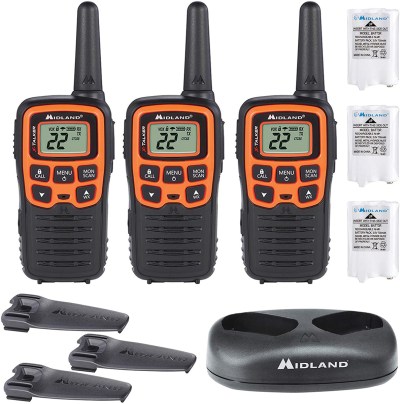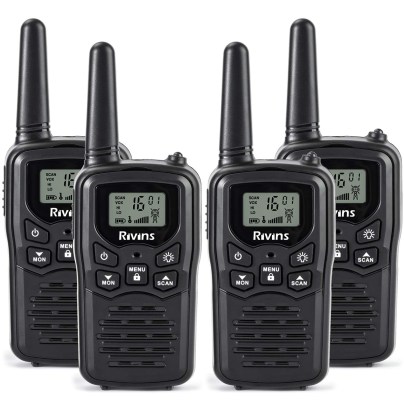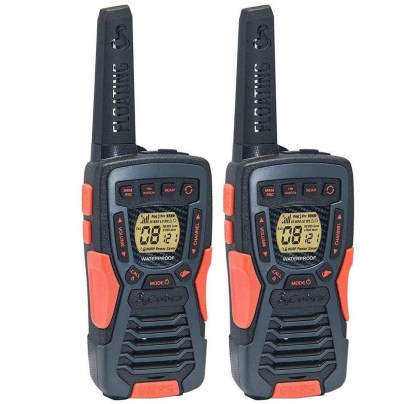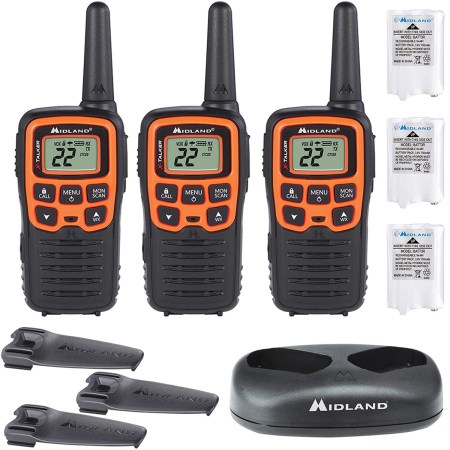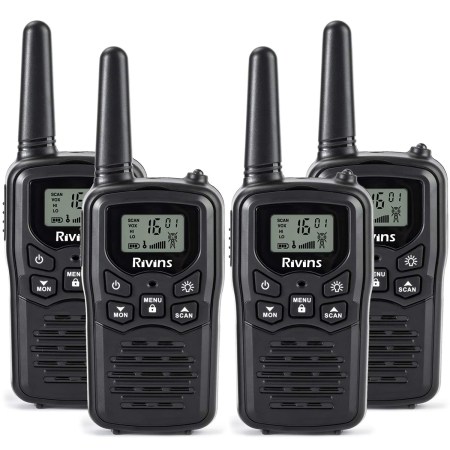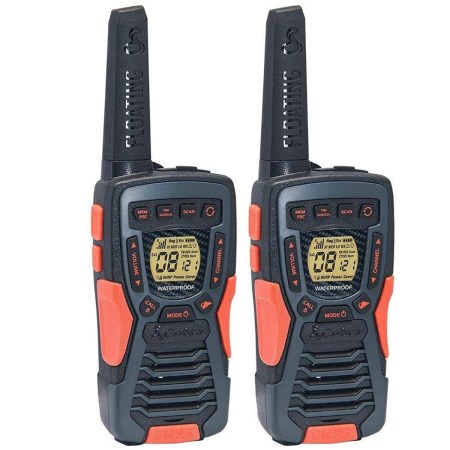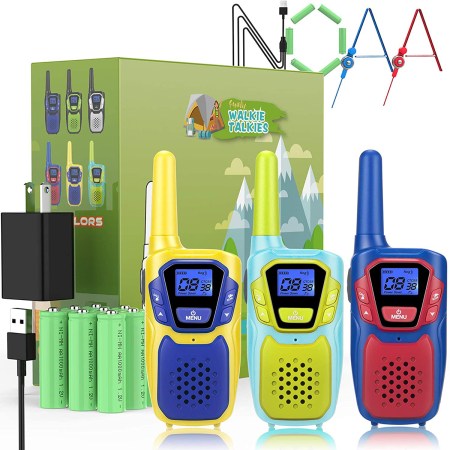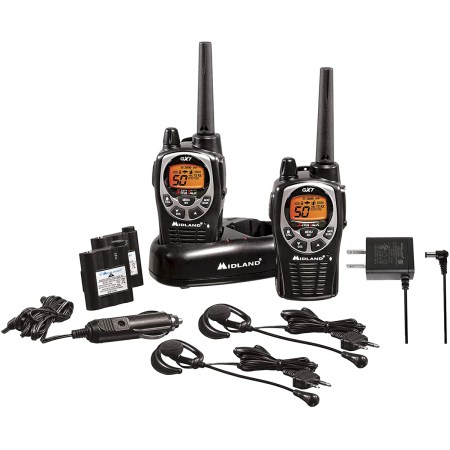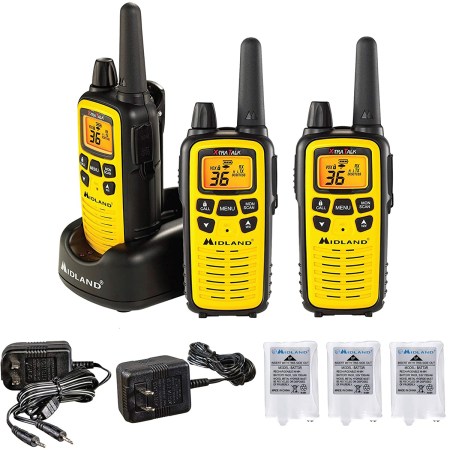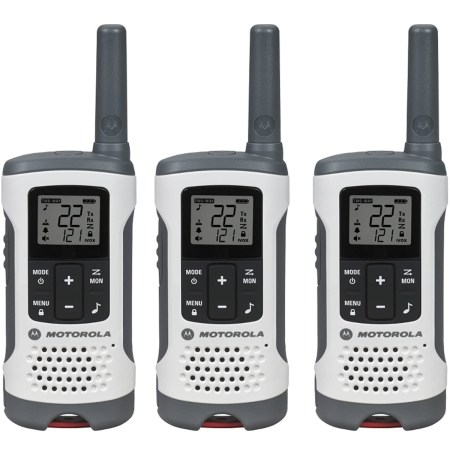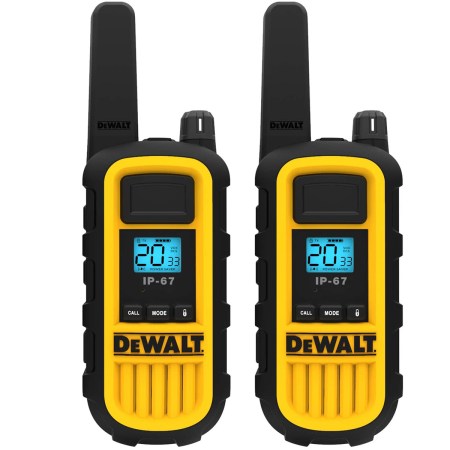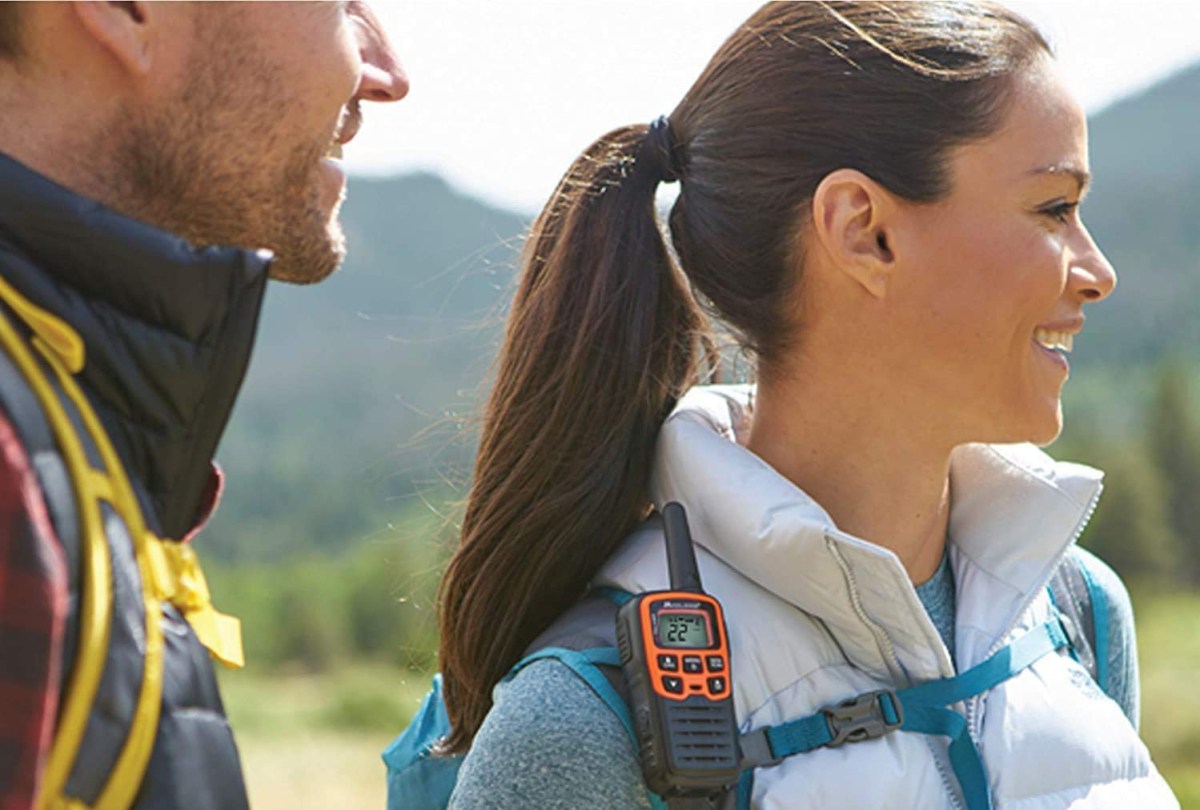
We may earn revenue from the products available on this page and participate in affiliate programs. Learn More ›
Walkie talkies, as the name suggests, are a subclass of two-way radio that allows you to walk and talk to nearby friends. Although these devices are often seen as toys for kids, these handy tools are useful for adult outdoor adventures as well. In particular, long-range walkie talkies are useful for skiing in groups and can be packed along with hiking or camping gear.
Walkie talkies can be used in numerous situations, depending on the type. For example, you can bring a set on a family cruise so that everyone can do their own activities while remaining connected. If the boat stops in port, some walkie talkies allow you to explore the town without worrying about a phone signal or the costly bills that can come with international communication.
Interested in snagging a new pair of walkie talkies for your next trip? Based on the range, specific activity, and affordability, we’ve narrowed it down to several of the best walkie talkies on the market.
- BEST OVERALL: Midland – X-TALKER T51VP3 FRS 2-Way Radio
- BEST BANG FOR THE BUCK: Rivins RV-7 Walkie Talkies Long Range 4 Pack
- BEST LONG-RANGE: COBRA ACXT1035R FLT Floating Walkie Talkies
- BEST FOR KIDS: Topsung Long Range Rechargeable Walkie Talkies
- BEST FOR EMERGENCIES: Midland 50 Channel Waterproof GMRS Two-Way Radio
- BEST FOR HIKING & CAMPING: Midland 36 Channel FRS Two-Way Radio – Long Range
- BEST FOR CRUISE SHIPS: Motorola T260TP Talkabout Radio, 3 Pack
- BEST FOR SKIING: DEWALT DXFRS800 2 Watt Heavy Duty Walkie Talkies

Types of Walkie Talkies
Walkie talkies can be split into two categories based on their intended radio service: Family Radio Service (FRS) and General Mobile Radio Service (GMRS).
Family Radio Service (FRS)
Most walkie talkies operate on the family radio service (FRS)—a personal radio service reserved for consumer use. These walkie talkies use FM waves, which come in clearer than AM radio waves and do not require a license to operate, as some GMRS walkie talkies do. For most situations in which you’d need short-distance two-way communication, a set of FRS walkie talkies should work.
General Mobile Radio Service (GMRS)
The general mobile radio service (GMRS) uses isolated frequencies within the FRS radio frequency range that regular FRS devices cannot use. Unlike FRS walkie talkies, GMRS walkie talkies can be modified to amplify their signal and boost their power. If you’re picky about sound quality and plan on using your walkie talkies frequently, GMRS radios may be the way to go.
An increase in power often translates to an increase in price. So if you’re a casual two-way radio user, an FRS should do the trick. Another factor to consider with GMRS walkie talkies is that to use them, you’ll need to purchase a license from the Federal Communications Commission (FCC). GMRS walkie talkies are suitable for broad-range applications where you may be a few miles from anyone else. GMRS walkie talkies are great to include in an emergency kit, for situations when extended range and added clarity could literally save lives.
What to Consider When Choosing the Best Walkie Talkie
Before you start shopping, take a minute to think about what you’re looking for. Are you interested in using your two-way radio for family trips, emergencies, or as a source of entertainment for the kids? Whether you intend to use your new device for one or more of those activities, keep these shopping considerations in mind before making a purchase.
Purpose
The first thing you should ask yourself is: How do I plan to use my two-way radio? This will be a great jumping-off point for your search.
- Long-range walkie talkies are great for boating, climbing, hiking, or other activities in which you may find yourself separated from your partner or group.
- Kids’ walkie talkies are designed with simplicity and durability in mind. Children’s walkie talkies provide straightforward controls encased in a tough exterior so that your kids can enjoy the device on their own, without breaking it.
- Emergency situations are unexpected and may require a long-range walkie talkie that offers helpful warning features, such as a weather band to warn you of approaching storms, out-of-range alarms so that you don’t wander too far from your group, and a built-in flashlight or emergency lighting system to help you see in foggy conditions.
- Hiking and camping trips are a great way to get out of the house and enjoy the outdoors, where a durable walkie talkie with waterproofing and weather-resistant features are ideal.
- Cruise ships may seem like a strange place for walkie talkies, but they offer a convenient way to communicate with family or friends without spending extra cash on an international phone plan. Walkie talkies with the appropriate range can be particularly beneficial when stopping in a port town. Hand one to each of your group members, and you can stay connected without ever using your cellphone.
- Skiing is another activity that may leave you in need of long-range communication. To avoid getting separated from your group on the hill, consider purchasing a waterproof walkie talkie with long-range capabilities. Some devices come with a secure clip to prevent them from getting lost on the slopes.
Size and Weight
By design, walkie talkies are intended to be lightweight and portable, meaning they’re small in size—a fact that’s usually overlooked while shopping. Smaller walkie talkies may have a lower power output, limiting the range, clarity, and effectiveness of the device. Before deciding on a final set of walkie talkies, think of how and where they’ll be used.
Range and Clarity
Range and clarity depend on the environment the devices are used in. For example, just because a product description says that the device has a range of 30 miles doesn’t mean that’s necessarily true. If weather conditions are perfect, the terrain between the two walkie talkies is completely flat, shielded from interference, and the signal is strong, the product may reach a range of 30 miles.
But this isn’t always the case. The reality is that obstructions are everywhere—uneven topography, walls, buildings, trees, and even fluctuations in temperature can change the way radio waves move through the air.
Battery Type and Life
Nowadays, most walkie talkies are designed with a built-in rechargeable battery that can hold a charge for hours. Even so, some walkie talkies still use disposable batteries like AAs and AAAs, which may be the best choice if you don’t have access to an electrical outlet. You can easily extend the battery life of both rechargeable and disposable batteries by turning the walkie talkie off when it’s not in use.
Channels
According to FCC regulations, FRS and GMRS are free to use most channels (or frequencies) in the range of 462MHz to 467MHz. FRS radios are limited to 0.5W on channels 8 through 14, and 2W on channels 1 through 7 and 15 through 22.
GMRS radios, on the other hand, are allowed a power increase up to 50W (for mobile units) on channels 15 through 22. In simpler terms, GMRS radio service allows consumers more range with higher power, while FRS users are limited in both aspects.
Emergency Features
Walkie talkies or radios are considered among emergency kit essentials for various natural disasters. Some walkie talkies designed for these scenarios include special emergency features such as built-in flashlights and weather alerts.
Emergencies are circumstantial. For example, you may not be hurt, but wandering lost in an isolated place can be a terrifying experience, especially if it’s icy, snowing, or foggy. A walkie talkie with an out-of-range alert, however, can help prevent this issue by sounding an alarm if you move too far from your partner or group.
Additional Features
While some walkie talkies are basic, especially those that are made for children, there are a variety of walkie talkies that come with additional features. More advanced devices may have a backlit digital screen or keypad that allows you to see the controls clearly, even in pitch-black conditions.
Some walkie talkies include a port for a headset or speaker for hands-free use and incoming message alerts so that you can take the walkie talkie out of your pocket or turn off the worksite radio before the transmission comes through. Talk confirmation is a similar feature that signals the beginning and end of transmission so that you know when to reply instead of having your message cut off.
Our Top Picks
With those shopping considerations in mind, finding the best walkie talkies for your next adventure shouldn’t be too difficult. These are among the top-performing options on the market in their respective categories.
Best Overall
Midland – X-TALKER T51VP3 FRS 2-Way Radio
Midland X-TALKER Walkie Talkies come in packs of two, three, six, 10, and 12, featuring 22 channels with 38 privacy codes per channel that you can use to talk to your friends, family, or colleagues. These walkie talkies also have a National Oceanic and Atmospheric Administration (NOAA) scanning system that scans nearby weather network radio reports and sounds an alarm to warn users of severe weather conditions approaching.
With a maximum range of 28 miles and an included case of 12-hour rechargeable batteries, these walkie talkies suitable for outdoor adventures when weather alerts and a long-range signal are important. The voice-activated transmission feature allows you to use the device without pressing buttons. When you want to use your walkie talkie, just scan the channels to find a clear connection and begin talking.
Best Bang For the Buck
Rivins RV-7 Walkie Talkies Long Range 4 Pack
Powered by four AAA batteries each (rechargeable and non-rechargeable, depending on user preference), this four-pack of FRS walkie talkies is affordable and efficient. Designed with an LCD display, these walkie talkies make it easy to see the battery status, signal status, and channel number. There’s also a built-in flashlight for nighttime use and a Voice Operated Transmit (VOX) feature that allows users to go hands-free.
These walkie talkies have a range of 5 miles in open fields and provide 0.6 to 1.2 miles of communication in built-up areas or areas with obstructed conditions, making this inexpensive pack ideal for family hiking or camping trips.
Best Long-Range
COBRA ACXT1035R FLT Floating Walkie Talkies
Securing a reliable long-range connection can be difficult depending on a number of intervening factors, including obstructions such as uneven topography or tall buildings. To help extend your range, choose a powerful set of walkie talkies like these COBRA FLT Floating Walkie Talkies. These devices have a maximum ideal range of 37 miles, waterproof construction, and come with a built-in flashlight containing an SOS mode in case of an emergency.
These walkie talkies are powered by three rechargeable AA batteries, but can also run on regular alkaline AA batteries. When a call is coming in, the walkie talkie will sound an audible call tone or vibrate to let you know. It can also replay missed radio calls and automatically record the last 20 seconds of an incoming call.
Best For Kids
Topsung Long Range Rechargeable Walkie Talkies
The colorful patterns on these three walkie talkies make it easy to split them up between children so that there isn’t any fighting about which one belongs to whom. They have a 1-mile range in subdivisions, allowing your kids to easily talk to one another. These channels each have 121 privacy codes so that you can ensure your kids are using a private connection for their calls.
When the low-battery alert notifies you that the walkie talkie is running low on power, you can charge the rechargeable AA batteries using the included USB cable. These FRS walkie talkies also have a backlit LCD screen that’s great for sleepovers and they’re drop-resistant, making them an ideal choice for kids.
Best For Emergencies
Midland 50 Channel Waterproof GMRS Two-Way Radio
Prioritizing safety, this two-pack of GMRS walkie talkies includes a built-in SOS siren that can be used to draw attention to your group for help. The walkie talkies also have NOAA weather scanning that connects to a national weather network and sounds an alarm if there is a risk of severe weather in the area so that you can prepare.
These walkie talkies have a 36-mile range and are powered by included rechargeable batteries. They can also be used hands-free with voice and sound activation transmission, and you can monitor two different channels at once, which is ideal for relaying messages in an emergency.
Best For Hiking u0026 Camping
Midland 36 Channel FRS Two-Way Radio – Long Range
Communicate with your group on a hiking or camping trip using one of 36 channels with 121 privacy codes per channel. These FRS walkie talkies use the NOAA weather scanner to find a weather channel, which can be used for regular updates and to warn you with an audible alarm of severe weather in your area so that you can pack up and head home or take appropriate shelter. The bright yellow color on these walkie talkies is easy to see, even in a dark tent.
You can choose to power the walkie talkies with either three AAA batteries per device or the included rechargeable battery pack. Disposable batteries are likely the better option if you will be away from an electrical source for more than 10 hours. These walkie talkies have an ideal range of 30 miles, though when you are hiking or camping, there will likely be many obstructions that can reduce this range.
Best For Cruise Ships
Motorola T260TP Talkabout Radio, 3 Pack
Pulling into port should be a fun, exciting adventure that lets you explore a new place—but when you travel with friends or family, it can be stressful to ensure the group stays together. With this pack of three FRS walkie talkies, you can stay in touch with your group from up to a 25-mile distance.
The walkie talkies can be used with the included rechargeable battery for up to 10 hours, or you can power them with three AA batteries for up to 29 hours, according to manufacturer testing. These devices also have 22 channels with 121 privacy codes, plus access to 11 different weather channels that can be used to keep you informed of weather alerts and emergencies.
Best For Skiing
DEWALT DXFRS800 2 Watt Heavy Duty Walkie Talkies
Don’t let yourself get separated from your friends or family on the ski slopes when you can use this two-pack of walkie talkies to keep in contact—in ideal conditions they have a range of up to 25 miles. The FRS walkie talkies are waterproof, dustproof, and shock-resistant, allowing them to withstand a 2-meter drop and water immersion in 1-meter-deep water for up to 30 minutes.
These walkie talkies have 22 preset channels with privacy codes to help reduce the interference from other devices, and you can access an impressive 2,662 channel combinations if the preset options aren’t giving you the privacy or clarity you want. The walkie talkies are powered with rechargeable lithium-polymer batteries that can last up to 18 hours on a single charge, allowing you to spend the whole day on the ski slopes.
FAQs About Your New Walkie Talkie
If you still have questions about walkie talkies, this FAQ may help.
Q. What is the difference between walkie talkies and two-way radios?
Technically, all walkie talkies are two-way radios, but not all two-way radios are walkie talkies. This is because a walkie talkie is defined generally as a handheld portable two-way radio. Because it’s a subclass of the larger two-way radio category, it’s difficult to pinpoint distinct differences beyond the portability and the small size of the walkie talkie.
Q. What is the best long-range walkie talkie?
Depending on where you are and how you want to use the walkie talkie, the best long-range option for you can differ based on individual product features. However, one of the best long-range walkie talkies is the COBRA ACXT1035R FLT Floating Walkie Talkies, which have a range of 37 miles over unobstructed terrain.
Q. Can any walkie talkie connect to another?
Yes, in theory, any walkie talkie can connect to another if they are on the same frequency and are within range, but most products have privacy codes that can be used to create private channels for direct communication with people you know.
Q. Can walkie talkies be traced?
Yes, but they’re extremely difficult to trace.
The single tracer method is only applicable if the walkie talkie is transmitting for a long period of time. It uses a portable antenna that is highly directional to pick up signals when it is pointing almost directly at the target signature. This means that you need to slowly rotate the antenna until the transmission can be detected, assuming that the walkie talkie doesn’t move. Even then, all you have is a direction and the assumption that the signal will grow stronger as you move toward it.
The triangulation method requires three stations that each have identical directional antenna systems operating on the same frequency. By directing the antennas toward the maximum signal strength from the walkie talkie, you can triangulate a position instead of simply determining a direction.
Q. How long do batteries last in walkie talkies?
The majority of walkie talkies have rechargeable batteries that can be used repeatedly without wearing out for at least two years. Walkie talkies powered by AA or AAA batteries can last for just one day or may have power left after a full year, depending on the usage of the walkie talkie and where it was kept, as heat and cold can influence the life of the batteries.
